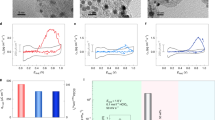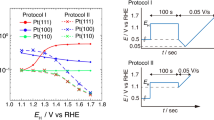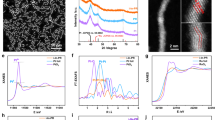Abstract
Tuning the surface structure at the atomic level is of primary importance to simultaneously meet the electrocatalytic performance and stability criteria required for the development of low-temperature proton-exchange membrane fuel cells (PEMFCs). However, transposing the knowledge acquired on extended, model surfaces to practical nanomaterials remains highly challenging. Here, we propose ‘surface distortion’ as a novel structural descriptor, which is able to reconciliate and unify seemingly opposing notions and contradictory experimental observations in regards to the electrocatalytic oxygen reduction reaction (ORR) reactivity. Beyond its unifying character, we show that surface distortion is pivotal to rationalize the electrocatalytic properties of state-of-the-art of PtNi/C nanocatalysts with distinct atomic composition, size, shape and degree of surface defectiveness under a simulated PEMFC cathode environment. Our study brings fundamental and practical insights into the role of surface defects in electrocatalysis and highlights strategies to design more durable ORR nanocatalysts.
This is a preview of subscription content, access via your institution
Access options
Access Nature and 54 other Nature Portfolio journals
Get Nature+, our best-value online-access subscription
$29.99 / 30 days
cancel any time
Subscribe to this journal
Receive 12 print issues and online access
$259.00 per year
only $21.58 per issue
Buy this article
- Purchase on Springer Link
- Instant access to full article PDF
Prices may be subject to local taxes which are calculated during checkout






Similar content being viewed by others
References
Turner, J. A. Sustainable hydrogen production. Science 305, 972–974 (2004).
Eberle, D. U. & von Helmolt, D. R. Sustainable transportation based on electric vehicle concepts: a brief overview. Energy Environ. Sci. 3, 689–699 (2010).
Hansen, J. et al. Dangerous human-made interference with climate: A GISS modelE study. Atmos. Chem. Phys. 7, 2287–2312 (2007).
Steele, B. C. H. & Heinzel, A. Materials for fuel-cell technologies. Nature 414, 345–352 (2001).
Rabis, A., Rodriguez, P. & Schmidt, T. J. Electrocatalysis for polymer electrolyte fuel cells: Recent achievements and future challenges. ACS Catal. 2, 864–890 (2012).
Stamenkovic, V. R. et al. Improved oxygen reduction activity on Pt3Ni(111) via increased surface site availability. Science 315, 493–497 (2007).
Nørskov, J. K. et al. Origin of the overpotential for oxygen reduction at a fuel-cell cathode. J. Phys. Chem. B 108, 17886–17892 (2004).
Stamenkovic, V. et al. Changing the activity of electrocatalysts for oxygen reduction by tuning the surface electronic structure. Angew. Chem. Int. Ed. 45, 2897–2901 (2006).
Paffett, M. T., Daube, K. A., Gottesfeld, S. & Campbell, C. T. Electrochemical and surface science investigations of PtCr alloy electrodes. J. Electroanal. Chem. 220, 269–285 (1987).
Bardi, U., Beard, B. C. & Ross, P. N. Surface oxidation of a Pt80Co20 alloy - An X-ray photoelectron spectroscopy and low energy electron diffraction study on the [100] and [111] oriented single crystal surfaces. J. Vac. Sci. Technol. A 6, 665–670 (1988).
Paffett, M. T., Beery, J. G. & Gottesfeld, S. Oxygen reduction at Pt0.65Cr0.35, Pt0.2Cr0.8 and roughened platinum. J. Electrochem. Soc. 135, 1431–1436 (1988).
Hammer, B. & Nørskov, J. K. Electronic factors determining the reactivity of metal surfaces. Surf. Sci. 343, 211–220 (1995).
Gauthier, Y. et al. PtxNi1−x(111) alloy surfaces: structure and composition in relation to some catalytic properties. Surf. Sci. 162, 342–347 (1985).
Bligaard, T. & Nørskov, J. K. Ligand effects in heterogeneous catalysis and electrochemistry. Electrochim. Acta 52, 5512–5516 (2007).
Hammer, B. & Nørskov, J. K. Theoretical surface science and catalysis — calculations and concepts. Adv. Catal. 45, 71–129 (2000).
Greeley, J., Nørskov, J. K. & Mavrikakis, M. Electronic structure and catalysis on metal surfaces. Annu. Rev. Phys. Chem. 53, 319–348 (2002).
Cui, C., Gan, L., Heggen, M., Rudi, S. & Strasser, P. Compositional segregation in shaped Pt alloy nanoparticles and their structural behaviour during electrocatalysis. Nat. Mater. 12, 765–771 (2013).
Beermann, V. et al. Rh-doped Pt-Ni octahedral nanoparticles: Understanding the correlation between elemental distribution, oxygen reduction reaction, and shape stability. Nano Lett. 16, 1719–1725 (2016).
Beermann, V. et al. Tuning the electrocatalytic oxygen reduction reaction activity and stability of shape-controlled Pt-Ni nanoparticles by thermal annealing - Elucidating the surface atomic structural and compositional changes. J. Am. Chem. Soc. 139, 16536–16547 (2017).
Van Der Niet, M. J. T. C., Garcia-Araez, N., Hernández, J., Feliu, J. M. & Koper, M. T. M. Water dissociation on well-defined platinum surfaces: The electrochemical perspective. Catal. Today 202, 105–113 (2013).
Farias, M. J. S., Camara, G. A. & Feliu, J. M. Understanding the CO preoxidation and the intrinsic catalytic activity of step sites in stepped Pt surfaces in acidic medium. J. Phys. Chem. C. 119, 20272–20282 (2015).
Gómez-Marín, A. M. & Feliu, J. M. Oxygen reduction on nanostructured platinum surfaces in acidic media: Promoting effect of surface steps and ideal response of Pt(111). Catal. Today 244, 172–176 (2015).
Sugimura, F., Nakamura, M. & Hoshi, N. The oxygen reduction reaction on kinked stepped surfaces of Pt. Electrocatalysis 8, 46–50 (2017).
Calle-Vallejo, F. et al. Finding optimal surface sites on heterogeneous catalysts by counting nearest neighbors. Science 350, 185–190 (2015).
Calle-Vallejo, F., Pohl, M. D. & Bandarenka, A. S. Quantitative coordination-activity relations for the design of enhanced Pt catalysts for CO electro-oxidation. ACS Catal. 7, 4355–4359 (2017).
Dubau, L. et al. Defects do catalysis: CO monolayer oxidation and oxygen reduction reaction on hollow PtNi/C nanoparticles. ACS Catal. 6, 4673–4684 (2016).
Li, M. et al. Ultrafine jagged platinum nanowires enable ultrahigh mass activity for the oxygen reduction reaction. Science 354, 1414–1419 (2016).
Chattot, R. et al. Beyond strain and ligand effects: Microstrain-induced enhancement of the oxygen reduction reaction kinetics on various PtNi/C nanostructures. ACS Catal. 7, 398–408 (2017).
Calle-Vallejo, F. et al. Why conclusions from platinum model surfaces do not necessarily lead to enhanced nanoparticle catalysts for the oxygen reduction reaction. Chem. Sci. 8, 2283–2289 (2017).
Langford, J. I. & Lou, D. Powder diffraction. Rep. Prog. Phys. 59, 131–234 (1996).
Stukowski, A., Markmann, J., Weissmüller, J. & Albe, K. Atomistic origin of microstrain broadening in diffraction data of nanocrystalline solids. Acta Mater. 57, 1648–1654 (2009).
Kurlov, A. S. & Gusev, A. I. Determination of the particle sizes, microstrains, and degree of inhomogeneity in nanostructured materials from X-ray diffraction data. Glas. Phys. Chem. 33, 276–282 (2007).
Le Bacq, O. et al. Effect of atomic vacancies on the structure and the electrocatalytic activity of Pt-rich/C nanoparticles: A combined experimental and density functional theory study. ChemCatChem 9, 2324–2338 (2017).
Montejano-Carrizales, J. M., Aguilera-Granja, F. & Morán-López, J. L. Direct enumeration of the geometrical characteristics of clusters. Nanostruct. Mater. 8, 269–287 (1997).
Montejano-Carrizales, J. M. & Morán-López, J. L. Geometrical characteristics of compact nanoclusters. Nanostruct. Mater. 1, 397–409 (1992).
Gan, L., Rudi, S., Cui, C., Heggen, M. & Strasser, P. Size-controlled synthesis of sub-10 nm PtNi3 alloy nanoparticles and their unusual volcano-shaped size effect on ORR electrocatalysis. Small 12, 3189–3196 (2016).
Gan, L., Cui, C., Rudi, S. & Strasser, P. Core-shell and nanoporous particle architectures and their effect on the activity and stability of Pt ORR electrocatalysts. Top. Catal. 57, 236–244 (2014).
Strasser, P. et al. Lattice-strain control of the activity in dealloyed core–shell fuel cell catalysts. Nat. Chem. 2, 454–460 (2010).
Grammatikopoulos, P., Cassidy, C., Singh, V. & Sowwan, M. Coalescence-induced crystallisation wave in Pd nanoparticles. Sci. Rep. 4, 5779 (2014).
Asset, T. et al. Elucidating the mechanisms driving the aging of porous hollow PtNi/C nanoparticles by means of COads stripping. ACS Appl. Mater. Interfaces 9, 25298–25307 (2017).
Kitchin, J. R., Nørskov, J. K., Barteau, M. A. & Chen, J. G. Role of strain and ligand effects in the modification of the electronic and chemical properties of bimetallic surfaces. Phys. Rev. Lett. 93, 4–7 (2004).
Kienitz, B., Pivovar, B., Zawodzinski, T. & Garzon, F. H. Cationic contamination effects on polymer electrolyte membrane fuel cell performance. J. Electrochem. Soc. 158, B1175–B1183 (2011).
Gan, L., Heggen, M., Rudi, S. & Strasser, P. Core–shell compositional fine structures of dealloyed PtxNi1−x nanoparticles and their impact on oxygen reduction catalysis. Nano Lett. 12, 5423–5430 (2012).
Oezaslan, M., Hasché, F. & Strasser, P. Pt-based core–shell catalyst architectures for oxygen fuel cell electrodes. J. Phys. Chem. Lett. 4, 3273–3291 (2013).
Zhang, J., Yang, H., Fang, J. & Zou, S. Synthesis and oxygen reduction activity of shape-controlled Pt3Ni nanopolyhedra. Nano Lett. 10, 638–644 (2010).
Bae, S. J. et al. Facile preparation of carbon-supported PtNi hollow nanoparticles with high electrochemical performance. J. Mater. Chem. 22, 8820–8825 (2012).
Henning, S. et al. Pt-Ni aerogels as unsupported electrocatalysts for the oxygen reduction reaction. J. Electrochem. Soc. 163, F998–F1003 (2016).
Ashiotis, G. et al. The fast azimuthal integration Python library: PyFAI. J. Appl. Crystallogr. 48, 510–519 (2015).
Rodríguez-Carvajal, J. Recent advances in magnetic structure determination by neutron powder diffraction. Phys. B Condens. Matter 192, 55–69 (1993).
Thompson, P., Cox, D. E. & Hastings, J. B. Rietveld refinement of Debye–Scherrer synchrotron X-ray data from Al2O3. J. Appl. Crystallogr. 20, 79–83 (1987).
Acknowledgements
This work was performed within the framework of the Centre of Excellence of Multifunctional Architectured Materials ‘CEMAM’ grant number ANR-10-LABX-44-01. The authors acknowledge financial support from the Grand Equipement National de Calcul Intensif (GENCI, grant number INP2227/72914), from the French National Research Agency (grant number ANR-14-CE05-0003-01), from the Swiss National Science Foundation (grant number 20001E_151122/1), from the German Research Foundation (DFG, grant number STR 596/5-1 and EY 16/18-1), from the German Federal Ministry of Education and Research (BMBF, grant number 03SF0527A), and from the European Research Council (grant number ERC AdG 2013 AEROCAT). The authors are grateful to Dr. Gwenn Cognard and Dr. Vincent Caldeira for their contribution to the manuscript's artwork.
Author information
Authors and Affiliations
Contributions
R.C., L.D. and F.M. conceived the experiments. R.C. carried out the experiments, analysed the data and wrote the first version of the manuscript. V.B., S.K. and L.K. contributed to materials synthesis. J.H., S.H. and T.A. contributed to electrochemical measurements. L.G. and G.R. contributed to HRTEM and STEM/X-EDS experiments. J.D. performed the WAXS experiments and P.B. the Rietveld analysis. O.L.B. and A.P. carried out the DFT calculations. All authors contributed to the discussion section and the finalization of the text and Figures of the manuscript.
Corresponding authors
Ethics declarations
Competing interests
The authors declare no competing interests.
Additional information
Publisher’s note: Springer Nature remains neutral with regard to jurisdictional claims in published maps and institutional affiliations.
Supplementary information
Supplementary Information
Experimental Details, Supplementary Figures 1–11, Supplementary Tables 1–6, Supplementary References 1–23
Rights and permissions
About this article
Cite this article
Chattot, R., Le Bacq, O., Beermann, V. et al. Surface distortion as a unifying concept and descriptor in oxygen reduction reaction electrocatalysis. Nature Mater 17, 827–833 (2018). https://doi.org/10.1038/s41563-018-0133-2
Received:
Accepted:
Published:
Issue Date:
DOI: https://doi.org/10.1038/s41563-018-0133-2
This article is cited by
-
Recent advances in morphology control of platinum catalysts toward oxygen reduction reaction
Frontiers in Energy (2024)
-
Imaging the strain evolution of a platinum nanoparticle under electrochemical control
Nature Materials (2023)
-
Size and near-surface engineering in weak-oxidative confined space to fabricate 4 nm L10-PtCo@Pt nanoparticles for oxygen reduction reaction
Nano Research (2023)
-
Modulating the electronic spin state by constructing dual-metal atomic pairs for activating the dynamic site of oxygen reduction reaction
Nano Research (2023)
-
PtNi-W/C with Atomically Dispersed Tungsten Sites Toward Boosted ORR in Proton Exchange Membrane Fuel Cell Devices
Nano-Micro Letters (2023)



